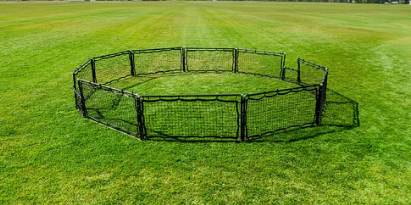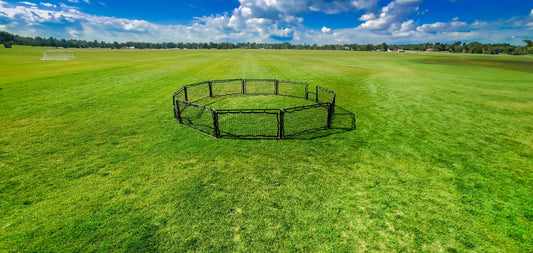In the world of sports, there are those that capture the heart and soul of their players and spectators alike, and then there's badminton—a game that does all this and more with its astonishing blend of grace, agility, and explosive power. As feathered shuttlecocks soar through the air, defying gravity and physics, badminton unveils itself as a sport that combines athleticism, strategy, and sheer excitement like no other.

Welcome to Castle Sports, where we embark on a thrilling journey into the world of badminton, exploring its rich history, its status as a global sporting phenomenon, and the incredible skills and dedication it demands from its athletes. Whether you're an aspiring player looking to improve your game or someone simply curious about this captivating sport, this article promises to be your ultimate guide to all things badminton.
From the rapid-fire rallies that leave audiences breathless to the strategic maneuvers that test players' mental prowess, badminton is a sport that transcends boundaries and captivates hearts. So, grab your rackets, lace up your shoes, and get ready to dive headfirst into the world of shuttle power—it's time to discover what makes badminton a true gem in the realm of sports.
Badminton, often regarded as one of the world's fastest racquet sports, has a rich and storied history that spans centuries. This game, known for its agility, precision, and quick reflexes, has evolved from a leisurely pastime played in royal courts to a global sport embraced by millions. Let's embark on a journey through time to explore the fascinating history of badminton.
Origins and Early Beginnings: The roots of badminton can be traced back to ancient civilizations. Games involving a shuttlecock, or a feathered projectile, were played by various cultures around the world. The exact origin of badminton, however, is believed to be in ancient India, where a game called "Poona" or "Poonah" was played. It was a sport typically enjoyed by the elite and involved using a feathered shuttlecock and racquets.
Battledore, often referred to as "battledore and shuttlecock," is an ancient game that served as a precursor to modern badminton. It is a racquet sport that was popular in various cultures across different regions, with origins dating back centuries. Here's an explanation of battledore:

Equipment:
- Battledore: The primary piece of equipment in this game is a flat wooden paddle or racquet known as a "battledore." Battledores were typically made from wood, and they had a handle for players to grip and a flat striking surface.
- Shuttlecock: In battledore, a shuttlecock was used as the projectile. The shuttlecock consisted of feathers or other lightweight materials attached to a base. Unlike modern badminton shuttlecocks, which have a conical shape, battledore shuttlecocks were often made with a rounded base.
Gameplay: Battledore is a racquet sport that involves hitting the shuttlecock back and forth between two players or teams. The objective of the game is to keep the shuttlecock in the air and prevent it from touching the ground. Points were typically scored when one player or team failed to return the shuttlecock.
The game could be played in various formats, including singles (one-on-one) or doubles (two-on-two). Players used the battledores to strike the shuttlecock with the intention of sending it over the net or a designated boundary to the opponent's side of the court.
History and Variations:
- Battledore has a long history and was played in different forms in various cultures. It was especially popular in Asia, Europe, and South America.
- In Asia, similar games were played under different names, such as "jianzi" in China and "hanetsuki" in Japan. These games also involved using a paddle or foot to keep a shuttlecock-like object in the air.
- In Europe, battledore and shuttlecock were often played as a leisurely pastime during the 17th and 18th centuries, particularly in England and France.
- Battledore eventually evolved into modern badminton in the mid-19th century in British India, where players began using a net and started incorporating rules similar to those in badminton today.
While battledore may not be as widely recognized or played today as modern badminton, it played a crucial role in the development of racquet sports. The concept of striking a shuttlecock with a racquet laid the groundwork for the more structured and competitive sport of badminton that we know today.
British Influence and the Birth of Modern Badminton: Badminton, as we know it today, began to take shape in British India during the mid-19th century. British army officers stationed in India were introduced to the game of Poona, and they brought it back to England. The sport gained popularity in British social circles, and it was often played at garden parties and among the British aristocracy.
In 1873, the sport was introduced at a party hosted at Badminton House, the Duke of Beaufort's country estate in Gloucestershire. This event is considered a pivotal moment in badminton's history and is where the sport got its name, "Badminton," after the venue.
Rules and Formalization: As badminton gained popularity in England, clubs began to form, and the rules of the game were gradually standardized. The Bath Badminton Club, founded in 1877, played a significant role in formalizing the rules of the game. The club published the first official rulebook in 1887, which laid the foundation for modern badminton.
International Spread and Competition: Badminton's popularity continued to grow, and it spread to other countries, including Scotland, Canada, and India. The All England Open Badminton Championships, established in 1899, marked the birth of competitive badminton. It remains one of the sport's most prestigious tournaments to this day.
In 1934, the International Badminton Federation (now the Badminton World Federation) was founded, further facilitating the global expansion of the sport. Badminton was included as an exhibition sport in the 1972 Olympics and later became an official Olympic event in the 1992 Barcelona Olympics.
Modern Badminton: Today, badminton is played and loved by millions of people worldwide. It's an Olympic sport that showcases the incredible athleticism, speed, agility, and precision of its athletes. The game has evolved significantly in terms of technique, equipment, and competitive standards.
Modern badminton is characterized by fast-paced rallies, incredible smashes, delicate net play, and strategic gameplay. It's played both recreationally and at the highest levels of international competition, with countries like China, Indonesia, and South Korea dominating the sport.
Badminton has several variations and formats that cater to different preferences, skill levels, and playing conditions. Here are some of the main variations of badminton played today:
- Singles Badminton: The most common and widely recognized form of badminton, where two players compete against each other on opposite sides of the court.
- Doubles Badminton: In doubles badminton, two teams of two players each compete on a larger court. There are two variations of doubles: men's doubles (two male players on each team) and women's doubles (two female players on each team).
- Mixed Doubles: Mixed doubles is played by teams of two, with one male and one female player on each team. This format emphasizes teamwork and coordination between players of different genders.
- Para-Badminton: A version of badminton designed for athletes with physical impairments. Para-badminton includes wheelchair badminton and standing events, with specific rules and adaptations to accommodate various disabilities.
- Wheelchair Badminton: Played by athletes with mobility impairments who use wheelchairs. It follows similar rules to standard badminton but with adaptations for players using wheelchairs.
- Speed Badminton (Speedminton): A variation of badminton that is played outdoors and without a net. Speedminton uses a different shuttlecock with a more stable flight for outdoor conditions. It focuses on speed and agility.
- Air Badminton: Developed by the Badminton World Federation (BWF), Air Badminton is an outdoor version of badminton designed to be played in various weather conditions. It features a modified shuttlecock and equipment suitable for outdoor play.
- Beach Badminton: Played on sandy beaches, this variation of badminton is less formal and often played recreationally during beach vacations. The wind and sand can affect the gameplay.
- Frescobol: While not technically badminton, it's a beach paddle sport played with a small ball, similar to beach paddleball. It shares some similarities with beach badminton but is distinct in its own right.
- Badminton Variations for Kids: There are simplified versions of badminton designed for children, such as mini-badminton or junior badminton. These adaptations use smaller courts and modified equipment to make the game more accessible to young players.
- Social or Recreational Badminton: Informal games of badminton are often played in community centers, clubs, and among friends for fun and exercise.
- Professional and Competitive Badminton: At the highest level, professional badminton is played in international competitions, including the Olympic Games, World Championships, and numerous tournaments organized by the Badminton World Federation (BWF).

These variations cater to a wide range of players, from beginners and casual enthusiasts to elite athletes and individuals with specific needs or preferences. The choice of which variation to play often depends on the players' skill levels, location, and available facilities.
From its humble origins as a pastime in Indian courts to its status as a globally recognized and respected sport, badminton's journey through history is a testament to its enduring appeal. With its thrilling gameplay and remarkable athletes, badminton continues to captivate hearts and inspire future generations of players, ensuring its place as one of the world's most beloved racquet sports. As we look ahead, it's certain that the shuttlecock will keep flying, and the courts will continue to echo with the sounds of athleticism and passion for many years to come.
In the exhilarating world of badminton, where lightning-quick reflexes meet graceful finesse, we've journeyed through a rich tapestry of history, skills, and competitive spirit. This sport, which began as an ancient pastime and evolved into an international sensation, has captured the hearts of millions across the globe.
As we conclude our exploration of the world of badminton, it's clear that this sport transcends boundaries. It unites players and fans from diverse backgrounds, cultures, and age groups, all drawn together by the magnetic allure of the shuttlecock. From the mesmerizing rallies that unfold on the court to the strategic battles of wits and endurance, badminton exemplifies the epitome of athleticism and dedication.
Badminton is not just a sport; it's a passion. It's a testament to the indomitable human spirit, pushing the limits of physical prowess and mental fortitude. Whether you're a casual player enjoying a friendly match at the local club or an elite athlete competing on the world stage, the magic of badminton is undeniable.
So, whether you're stepping onto the court for the first time, honing your skills to perfection, or cheering for your favorite players from the sidelines, remember that badminton is a journey—a journey of self-improvement, camaraderie, and endless discovery.
In the world of badminton, every rally is a story, every shuttlecock a chance, and every player a hero in their own right. As you continue your journey through this captivating sport, may your rallies be swift, your smashes unstoppable, and your love for badminton everlasting. Here's to the shuttle power that fuels our passion and keeps us coming back to the court, time and time again.
For other net based games check out the versatile Infinets to meet each of your game need!







